Gens Una Sumus!
Newsletter #934
September 12, 2020
By Abel Talamantez
Table of Contents
- The Unconventional Chess Club
- Community Tuesday Night Marathon Report
- Weekly Classes
- Scholastic Online Offerings
- Online Events Schedule
- TD corner
- FM Paul Whitehead's Column
- GM Nick de Firmian's Column
- Submit your piece or feedback
The Unconventional Chess Club and The Days of Long Ago
The Mechanics' Institute has been adapting to the changes caused by this global pandemic, including what it means to play chess. I think many of us see the writing on the wall: The way we play chess may forever change, or at least it will be some time before we play and socialize through chess the way many of us remember. There have been many articles written lately about the psychological impact the shelter in place and the change of routines has had on people. For those of us that love the game of chess, the temporary loss of the thrill and enjoyment of live play, whether it be rated or non-rated casual play, is something many of us feel.
I met up in San Francisco with a coach last week for a socially-distant coffee meeting by Mechanics' Institute, and he expressed a feeling of loss at not being able to go into the club. The feeling of just being inside the chess room, with all its history and memories, was something of a personal fulfillment that felt now taken away. He has been a member of the Institute for decades, so Mechanics' is part of his life. While Mechanics' being closed may not be the biggest concern in his life, the meeting reminds me that the love we have for our club or for how we play the game of chess for chess players remains an emotion that impacts our psychologocal state.
When thinking about chess clubs, I started remembering my childhood and my start in chess. I have previously written about getting my start at the Kolty Chess Club in Campbell, California, a club that still operates to this day. What I also remember is going as a young teenager to a pizza place just down the street from Kolty on Friday nights (Kolty has always been Thursday nights) called The Garret.
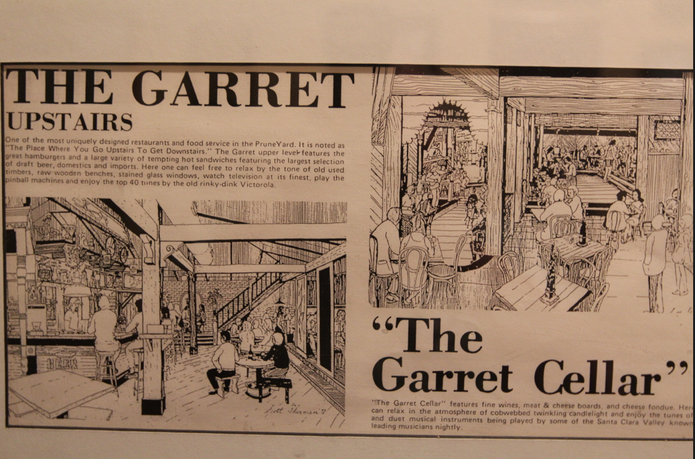
The layout of the Garret pre-1993
In the 1980's, The Garret was a two story pizza place in the Pruneyard in Campbell, California. Established in 1971 in a plaza shopping center near downtown Campbell, it was a hub on Friday nights. The Garret was a special place. It's two-story building, and the sheer size attracted many people, especially on Friday nights. Pizza, sports on televisions, arcade games - it had it all. What it also had was a steady crop of chess players looking to hustle games for beers and dollars. As a chess-playing teenager, my friends and I would go there to play video games and eat pizza mostly, but we would love to watch the adults play blitz with everything on the line, and by everything, I mean a glass of Budweiser or a silver dollar. If you watched them play, you would think a lot more was on the line, such the nature of chess players. There was one player in particular that I remember, he appeared to be of Irish descent, red beard and all, who was a regular there and was always playing blitz for beers. It was a form of entertainment in itself to come and watch him play. He had a unique look and character, and the way he played the game was akin to a magician that uses misdirection, charm, and storytelling to lure the audience in and dazzle them with the act. It was like watching Hulk Hogan wrestle, or Muhammed Ali box. For these athletes, it was as much about how they practiced their art as much as their raw talent. I don't remember ever playing him, but some of my friends did. They donated a healthy (or unhealthy) dose of Friday drinks to this gentleman. But for my friends, chess was no different than playing an arcade game, pushing quarters into a machine for an evening of entertainment.
I don't remember the video games I played there, but I remember the chess action. Almost every chess player has a story like this, whether it be playing at a coffee house or park, the streets of San Francisco or at a restaurant. Gatherings like this are every bit as important as any organized USCF affiliate. The US Chess Clubs Committee has affirmed this also, recognizing and offering support to any club or gathering of people that promotes the playing of chess whether it is USCF rated or not. I've walked the streets of San Francisco while heading to the CalTrain station for my ride back to San Jose and have seen people playing chess at tables outside coffee shops and games in the park. I've seen chess played literally on sidewalks. It is a special thing for us to be able to enagge in chess with people from anywhere in the world. Chess is its own universal language in which people can come together and engage in despite being from different cultures and not even needing to speak the same language. Additionally, you can play anywhere, rain or shine, and the cost of materials is relatively cheap and very portable. With people that love to play sports for example, you need a field to play. If I enjoy tennis, I have to go to a tennis court. If football or baseball, I at least need a park. Chess however, can be played anywhere, so there are no limits to how people can socialize through chess.

Street chess on Market street is no longer there, but chess played in the streets of San Francisco was alive and well, before the current shelter-in-place.
Now things ahve changed dramatically, at least for now, but playing chess online keeps the games going and the people talking. If you haven't experienced our Tuesday Night Marathons online, you should give it a try. We have 60 players participate regularly, and viewers can follow the coverage of the games and people can enter comments in the chat. Although it is differnet of course from the live experience, it is warming to see the chess community engaged, talking, joking, criticizing in some cases - all part of the human experience. It at least reminds us that we are all still an active community, and I belive this means something.
The Garret closed its doors in 1993 because of rising rents, and then reopened in 1997 at a different location, just blocks from the Pruneyard. While it has survived and preserved its own history, the feeling of the days of long ago had passed, at least for those of us that remember it for its chess action. Time changes things, and while I have fond memories of that time, in that building, with those people, time also presents new opportunities to make new memories and create new experiences. As organizers of chess events, we share a particular responsibility to provide that for players, especially during these times. This is a challenge because we also recognize that almost everything we know about a chess experience is from live over the board play, and it is uncertain when we will feel that again, or if we will ever experience it in the same way again.
We must remember that as a society, we have been through wars and pandemics before, and life has gone on to experience economic prosperity and technological innovation. It all just takes time. Chess players can be a persistent bunch, especially since chess can be played in a myriad of unconventional places. Our job is to encourage participation, offer options, and support those who want to find ways to safely play. Maybe one day someone will reflect on online clubs and events the way I remember The Garret. Ultimately, I belive that it is not the type of events or options that will be remembered, but the fact that we value community, it is not about the chess per se, it is about the people. The Garret was a special because it was a unique gathering place, it enhanced the local chess action and provided the perfect venue for the chess hustlers and blitz afficianados. Many people feel the same about the Mechanics' Institute chess room, albeit without gambling. Locations matter, but they matter because of the history before it, and this history is about the people.
Mechanics' Instititute Community Tuesday Night Marathon
The Mechanics' Institute's Community Tuesday Night Marathon, our September 2020 installment of our flagship event, kicked off on Tuesday night (football pun intended as NFL games are scheduled to start this week). We currently have 52 players currently for this 6-round G/35+2 USCF rated event. This event was named in honor of the amazing chess community at the Mechanics' Institute.
The top section is strong, with GM Aleksandr Lenderman, FM Kyron Griffith, IM Elliott Winslow, WGM Carla Heredia, and NM Ruiyang Yan representing the top 5 seeds. Although some of the games were well contested, there was only one significant upset among the top five players. Ashik Uzzaman, the cagey veteran Mechanics' player who is always good for a solid game kept his cool in a time scramble and converted a win against WGM Carla Heredia after equalizing was looked like a bad position out of the opening. Kristian Clemens put up some brave resistance in round 2 against GM Aleksandr Lenderman, but the top GM's skills and advantage proved too much. Perfect scores after the first two rounds include Aleksandr Lenderman, Kyron Griffith, Elliott Winslow, Ruiyang Yan, Alex Chin, Pranav Sairam, Arul Viswanathan, and Ashik Uzzaman.
In the under 1800 section, Erika Malykin is the top seed and closed the forst 2 rounds with 1.5/2. Previous TNM under section winner Pranav Pradeep will face some stronger competition the time around, but finishes the first couple of rounds with 2/2. Andrew Ballantyne delivered the big upset in this section on Tuesday, defeating Nursultan Uzakbaev. Pradeep, Martin Camacho and Andrew Ballantyne are at 2/2.
Here are some games from rounds 1 & 2, annotated by GM Nick de Firmian.
(5) GM Aleksandr Lenderman 2717 (AlexanderL) - Kristian Celemens 1997 (kclemens) [A11]
Live Chess Chess.com
[de Firmian,Nick]
1.Nf3 d5 2.e3 This has become a fairly regular couple of moves, even at the highest level, in recent years. The idea is to play the transposition game. To try to get Black into certain lines, and avoid others. But on principle it has a problem: about the queen's bishop. 2...Nf6 3.c4 c6 4.Nc3 e6 This is one solid way for Black to go, thinking some sort of Meran Defense -- if/when White plays d2-d4! Black certainly has no shortage of choices though: [Bishop developments: 4...Bg4; 4...Bf5; Slav Fianchetto systems: 4...g6; Even 4...a6 is fairly popular, as in the Slav looking for ...b5 even though it makes even less sense here.] 5.b3 White solves that bishop problem first, while the a5-e1 diagonal is solid. 5...Be7 A bit misdirected. Black might show more concern for the key disputed square e5. [5...Nbd7 is, somehow, the most popular move,; while 5...Bd6 is second.] 6.Bb2 0-0 7.d4 And back to a more well-known position. 7...Nbd7 8.Bd3 dxc4 A double-edged sequence, as White now takes gets quite the pawn center. [8...b6 is the slow approach, putting the bishop along a center diagonal before undertaking action.] 9.bxc4 c5 10.d5 exd5 11.cxd5 Nb6!? Sensible, to pressure d5 so that e4-e5 is discouraged while preparing to develop that last minor piece. [But 11...Bd6 to batten down on e5 is the other way to go (and the computer's choice). There is still the long diagonal for the other bishop, perhaps with ...a6 first.] 12.e4 Bg4 13.0-0
 |
13...Nfd7?! Maybe not the best maneuver. [13...c4 14.Bc2 Re8 with futures for the dark-squared bishop.] 14.Rb1 [14.h3! puts Black to the fire and on the brink of lost. 14...Bxf3 gives White a dangerous two bishops to go with his center (but 14...Bh5 15.g4 Bg6 16.e5 risks being overrun) ] 14...Ne5 15.Be2 Nxf3+ 16.Bxf3 Bxf3 17.Qxf3 Bf6 18.Ba1 Somewhat indulgent. Moving the queen and sending up the center was straightforward. 18...Qd7 19.Qd3 Bd4 That strong bishop has to go. 20.Ne2 Bxa1 21.Rxa1
 |
21...f5! hoping to weaken those center pawns. 22.f3 Rad8?! [22...Qd6 keeps rook options open, advantageously.] 23.Nf4! A knight sinking in (eventually) to e6 will send panic to Black's position. 23...Qd6 24.Qe3 [24.Ne6?? Qxe6; 24.g3! looking for alternatives for White's queen, not to mention exf5.] 24...Qe5 [24...Nc4! 25.Qc1 fxe4 26.fxe4 Qe5 with tactical defense based on problems with that last undeveloped rook on a1: 27.Ne6?? Rxf1+ 28.Qxf1 (28.Kxf1 Nd2+! 29.Qxd2 (29.Kg1 Nxe4 sets up smothered mate, so there's no time to take the rook.; 29.Ke2 Qxe4+ and ...Rxd5(+)) 29...Qxa1+) ] 25.Rae1 Now White is secure 25...fxe4?!
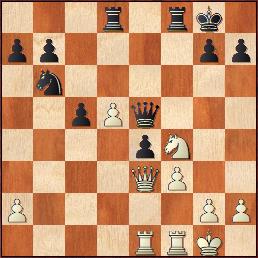 |
[25...Rde8 26.Ne6 Rf6 is still going to be tough.] 26.fxe4? [26.Ne6! Nxd5 27.Qxe4 Qxe4 28.fxe4 wins material] 26...Rde8?! [26...Rc8 Black shouldn't forget his own counterplay; White's advantage now would be nominal.] 27.g3 [Stockfish can't settle between 27.Ne6 Rxf1+ 28.Kxf1; and 27.Qg3 , but they're both clear advantages.] 27...Qc7? Giving up the c-pawn and the game. [27...Nd7; 27...Rc8; 27...c4] 28.Ne6! [28.e5 is also quite strong] 28...Rxf1+ 29.Rxf1 Qe5 30.Qf2! This in-between move throws Black's game out of order. 30...Qf6 31.Qxc5 Nd7 32.Qb5 Qe7 33.Qxb7 There's nothing left. 33...a5 34.e5 The back-rank problems persist. 34...h6 35.Qc7 a4 36.Rf2 Rb8 37.Kg2 a3 38.Qc3 The queen was well posted where it was -- and, there was a shot! [38.h4; 38.Rf5; 38.Nxg7! works!] 38...Nb6 39.Qf3 Nd7 40.Qf5 Still in the win zone, according to the computer... 40...Rb2 41.d6 Rxf2+ [41...Qe8!?] 42.Kxf2 Qe8 43.Nc7 Qxe5 44.Qxe5 The "human" move, going into a winning ending. [44.Qxd7! is the computer saying "there is no perpetual."] 44...Nxe5 45.Nb5 Kf7 46.Ke3 Ke6 47.Kd4 Nf3+ 48.Kc5 Nxh2 49.Kc6 Nf3 50.Kc7 Ne5 51.Nxa3 h5 52.Nc2 g5 53.Nd4+ Kd5 54.Nf3! Nxf3 55.d7 h4 56.d8Q+ Ke4 57.gxh4 gxh4 58.Qd7 Kf4 59.Qh3 Kg5 60.Qxf3 1-0
(6) Felix German 1976 (FelixGerman) - FM Kyron Griffith 2470 (KyronGriffith) [E24]
Live Chess Chess.com
[de Firmian,Nick]
1.d4 Nf6 2.c4 e6 3.Nc3 Bb4 4.Nf3 This is a flexible move "waiting" to see how Black develops before defining White's strategy. 4...c5 [4...b6 5.Bg5 is more a Queen's Indian than a Nimzoindian now, compared to the Leningrad System (4.Bg5)] 5.a3?! There are problems here: since Black hasn't played ...d5, White will remain stuck with doubled c-pawns. And the knight on f3 is in the way of the f-pawn. Usually White would like to deploy Bd3/Ne2. [5.e3 returns to the old main line (next Bd3, 0-0) without White having any Nge2 variations.; 5.g3!? harks back to a Kasparov-Karpov opening battle that raged across two of their world championship matches, and is still a difficult line.] 5...Bxc3+ 6.bxc3 Qa5 Black leans in right away. 7.Qc2 Ne4 8.Bd2 Of course taking the knight fails. 8...Nxd2 9.Qxd2
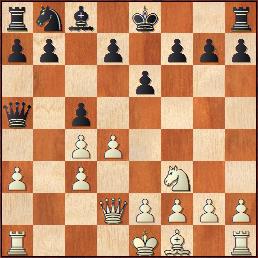 |
9...cxd4!? Kyron figures the remaining c-pawn will be just as weak, not to mention that the queens coming off reduce White's attacking chances. 10.cxd4 Nc6 11.e3 [White's clearest road to equality is 11.d5 Qxd2+ 12.Nxd2 Na5 13.e4 b6 14.h4=] 11...b6 12.d5?! [12.Bd3] 12...Qxd2+ 13.Nxd2 Na5 14.Bd3 Bb7 15.e4 d6?! [15...Ke7!? After all, that dark-square highway is just made for the king to cruise on.] 16.0-0 Rc8 17.f4 0-0 18.f5?! Bad bishops matter. 18...e5?! [18...Rfe8 keeps open possibilities along the e-file.] 19.Rac1 Ba6 20.Rc3 Rc5 21.Rfc1 Rfc8 threatening ...b5 22.a4 Black needs the famous "second weakness" (in White camp). 22...R5c7 23.Kf2 f6 24.Ke3 [24.h4] 24...g6?! [24...g5!=] 25.fxg6?! improving Black's pawn structure [25.h4!] 25...hxg6 26.h3 Kg7 27.Be2
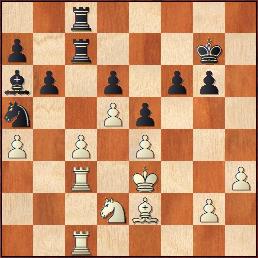 |
27...f5 Perhaps premature. Black didn't get anywhere with the pressure on c4, so maybe it's time to find new posts for the minors. 28.g3? [28.exf5 gxf5 29.g4! Black is ready to swing one rook over to the kingside, but is that enough for an advantage? 29...f4+!=/+ Between ...Rh8 and ...Nb7-c5, Black has some hope to get things going.f] 28...Rh8 29.Bf1?! Nb7 [29...Rf7! 30.Nb3 f4+ borders on winning.] 30.Nb3 Rf7 31.a5!? White is happy to trade off a weakness.
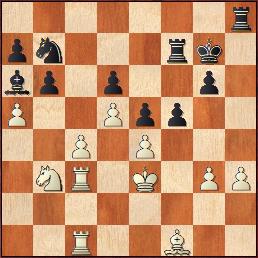 |
31...fxe4? [31...Nc5 32.Bg2 Na4 33.R3c2 bxa5! 34.Ra1 Rb8! 35.Nd2 Rb4 36.Rca2?! (36.Bf3 Bc8-/+) 36...Nb6-+] 32.Kxe4? forgetting to capture first [32.axb6 axb6 33.Bg2 Nc5 34.h4 is equal as White is getting ready to take on c5 and then, finally, on e4 without any nasty rook penetration.] 32...bxa5!-+ 33.Ra1 Rf2 [33...Rhf8!] 34.Nxa5? [34.Rf3 Rb2 35.Nxa5 Nc5+ 36.Ke3-/+] 34...Nc5+ 35.Ke3 Now the white king is a target and the game is lost 35...Rhf8-+ 36.Be2 Rg2 37.Bf3 Rxg3 38.Kf2 Ne4+ 0-1
(7) Nitish Nathan 1941(BreatheChessAlways) - NM Ruiyang Yan 2242 (jij2018) [D00]
Live Chess Chess.com
[de Firmian,Nick]
1.d4 Nf6 2.Bf4 d5 Rui is often content to play quiet lines -- quiet at first. [2...g6; 2...e6; At the other end of the spectrum is the radical 2...c5 3.e3 Nd5!? 4.Bg3 Qb6!? 0-1 (47) Prie,E (2508)-Korobov,A (2647) Aix les Bains 2011 CBM 142 Extra [Marchand,A/Primel,D]] 3.e3 e6 4.Nd2 Bd6 5.Bg3 0-0 6.c3 c5 7.Ngf3 b6 [7...Qc7!? prepares ...Nbd7] 8.Bd3 Bb7 9.0-0 Nc6 10.Qc2 [10.Qe2 Bxg3 11.hxg3 Ne7 12.dxc5 bxc5 13.e4 Ng6 14.Rad1 Qb6 15.b3 Rad8 16.e5 Nd7 17.c4 d4 18.Rfe1 h6 19.Be4 Bxe4 20.Qxe4 Qa5 21.Qc2 Qc7 22.Qe4 Qa5 23.Qc2 Qc7 1/2-1/2 (23) Harikrishna,P (2763)-Nakamura,H (2787) chess.com INT 2016] 10...Ne7
 |
11.e4? [Preferrable is 11.dxc5 bxc5 12.c4 leaning a bit on Black's pawn center.] 11...Bxg3 12.hxg3 c4! 13.Be2 dxe4 14.Ne5 b5 And Black has won a center pawn. 15.a4 a6 16.axb5?! axb5 17.b3? Nf5 Not bad, but [17...e3! 18.fxe3 Nf5 is won for Black. White may win on c4, but everything else collapses.] 18.g4? Nd6? [18...Rxa1 19.Rxa1 Nxd4! Is an immediate tactical win. Playing quietly can become a dangerous habit! You miss things.] 19.bxc4 bxc4 20.Ndxc4 Black's advantage has evaporated. 20...Nxc4 21.Nxc4 Rc8?! 22.Ne3 [22.Rfb1] 22...Nd5 23.Nxd5 exd5= 24.Rfb1 [24.Qd2; 24.Ra7; 24.f3] 24...Bc6 25.Qd2 Qd7 26.Qf4 Kh8? [26...Qd8] 27.g5+/- Qe7 28.Rb6 [28.Ra5] 28...f6 [28...Qd8] 29.gxf6+/- Rxf6 30.Qh4?! [30.Qe5; 30.Qg5] 30...e3 [30...Qc7] 31.f3??
 |
[31.f4! is some advantage for White. One slip is all it takes in chess!] 31...Qc7!-+ Threatening both the rook on by and 32...Rh6 32.Ba6 Re8 33.Rbb1 Rh6 34.Qg4 Qh2+ 35.Kf1 Rg6 36.Qh3 Qxh3 The endgame is good enough, but even better is [36...Qf4] 37.gxh3 Bd7 38.Bb5 Bxh3+ 39.Ke2 Rg2+ 40.Kd3 Rd2# 0-1
(8) WGM Carla Heredia 2227 (mathandchess2020) - Ashik Uzzaman 1940 (ashikuzzaman) [B52]
Live Chess Chess.com
[de Firmian,Nick]
1.e4 c5 2.Nf3 d6 3.Bb5+ Bd7 4.Bxd7+ Qxd7 5.0-0 Nc6 6.c3 Nf6 7.d4!? A sharp gambit requiring some preparation if you land here as Black. [7.Re1 and 7...e6 8.d4 cxd4 9.cxd4 d5 10.e5 Ne4 11.Nbd2 Nxd2 12.Bxd2 Be7; 7.Qe2 are the quieter lines.] 7...cxd4 [7...Nxe4 8.d5 Ne5 is the critical continuation.] 8.cxd4 Nxe4 Gutman's "a bold decision" is a euphemism -- Black takes quite a risk grabbing this pawn! [8...d5 9.e5 Ne4 10.Ne1 h6 (or 10...f6 when 11.f3 Ng5 12.Bxg5 fxg5 13.f4 starts quite an initiative.) 11.f3 Ng5 12.Nc3 Black isn't comfortable yet.] 9.d5 Ne5 10.Nxe5 Gives Black an unusual spot for his knight. [10.Re1!? Nxf3+ (10...Nf6) 11.Qxf3 Nf6 12.Nc3 is cramped but Black could still survive.] 10...dxe5 11.Re1 Nd6 12.Rxe5 g6
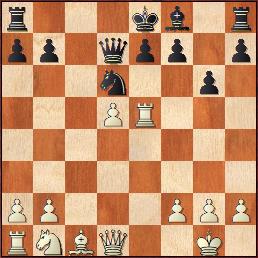 |
Black has given back the pawn and looks to get some time attacking the rook, but White strikes first. 13.Bg5 h6 14.Bf6 Rg8 15.Bh4?! [15.Re2!? 0-0-0 16.Bd4 Kb8 17.Nc3 Bg7 18.Bxg7 Rxg7 19.Qd4 Rgg8 20.Rae1 Rge8 21.Qh4 Nf5 22.Qf4+ Qc7 23.Qxc7+ Kxc7 24.g4 1-0 (54) Turner, M (2325)-Demirel,T (2335) Sas van Gent 1992] 15...Nf5 and Black equalizes, finally dealing with that bishop. 16.Bg3?! [16.Re4] 16...Bg7 [16...Rd8!] 17.Re2 Nxg3 18.hxg3 Rd8 19.Nc3 Bxc3 20.bxc3 Qxd5 21.Qa4+ Kf8 22.Qxa7 Rd7 23.Rae1 Kg7 [23...e6] 24.Qa4 Black offered White a forced line leading to perpetual. By declining White was psychologically affected to play for a win, which at this point turned reckless. [24.Rxe7 Rxe7 25.Rxe7 Qd1+ 26.Kh2 Qh5+=] 24...b5 25.Qb4 e6 26.Re5 Qxa2 27.Rxb5 Rgd8 White has two pawn islands and Black only one. 28.Qf4 Rd5 29.Rb7?!
 |
29...Rf5! 30.Qe3 Qd2 [30...Rd3! is even better] 31.g4 Qxe3-/+ 32.Rxe3? [32.fxe3] 32...Rd1+ 33.Kh2 Rxf2-+ 34.Rxe6 Rdd2 The double rook ending is an easy win for Black. 35.Ree7 Rxg2+ 36.Kh3 Rgf2 37.Kg3 g5 38.c4 Rf4 39.c5 Rd3+ 40.Kg2 Rxg4+ 41.Kf1 Rf4+ 42.Ke2 Rc3 43.Rbc7 Rf5 44.c6 Rf6 0-1
(3) CM Ethan Boldi 2120 (etvat) - Jwalin Shah 1832 (jshah1331) [A08]
Live Chess Chess.com, 09.09.2020
[de Firmian,Nick]
1.Nf3 d5 2.g3 c5 3.Bg2 e6 4.b3 Nf6 5.Bb2 g6 It is unusual to place the black pawns on both e6 and g6 as both moves allow the development of the dark-squared bishop so only one of them is needed, 6.d3 [6.0-0 Bg7 7.c4!?] 6...Bg7 7.Nbd2 Nc6 8.0-0 0-0 9.Re1 b6 10.e4 Bb7 Both sides have developed with double fianchettoed bishops and pawns contesting the center. Chances are even. 11.Qe2 d4 12.c3 dxc3 13.Bxc3 Ba6 [13...Qe7 14.Nc4 Rad8 would be direct central play] 14.Nc4 Qc7 15.Qb2! Power on the long diagonal. 15...Ne8 16.Rad1 [16.Nce5!] 16...Rd8 17.a4 Nb4?! [17...Bxc3 18.Qxc3 Bxc4 19.dxc4 Rxd1 20.Rxd1 e5! would give Black the fine outpost on d4] 18.d4 Nd6 19.d5? [19.Nce5!] 19...Bxc3 20.Qxc3
 |
20...exd5? missing the tactic [20...Nxe4! 21.Rxe4 exd5 22.Ree1 dxc4 winning a pawn with a great position] 21.exd5 Nf5 22.Nfe5 Now White is getting control of the central squares. 22...h5 [22...Nd4? 23.Rxd4 cxd4 24.Qxb4] 23.g4! Ng7?! [Black needed to be creative to stay in the game. 23...Bxc4 24.bxc4 hxg4 25.Nxg4 Rd6 26.Nf6+ Rxf6 27.Qxf6 Nc2 28.Re4 Ncd4 would at least give Black a great knight outpost on d4 for the exchange] 24.d6 Qc8 25.gxh5 Nxh5 26.d7 This pawn has become a monster. 26...Qc7 27.Rd6! Bxc4
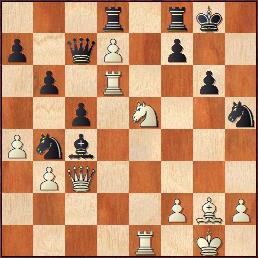 |
28.Nxg6! Wonderful! The centralized white pieces crash through for a decisive attack. 28...fxg6 29.Qxc4+ Kg7 30.Re7+ Kh6 31.Qe6 Nf4 32.Qe5 Black is playing the best defense, but it is just complete domination from the white pieces. 32...Nbd3 33.Rxg6+ Nxg6 34.Qxc7 [The computer finds 34.Qg7+ Kh5 35.Qh7+ Kg5 36.h4+ Nxh4 37.Rg7+ Kf6 38.Qh6+ Ke5 39.Qe3+ Kf6 40.Qe7+ Kf5 41.Bh3+ Kf4 42.Qe3#] 34...Nxe7 35.Qd6+ Ng6 36.Qxd3 Rf7 37.Bc6 Anyway the monster d-pawn decides the game 37...Nf8 38.Qh3+ Kg7 39.Qg3+ Ng6 40.h4! Rf6 41.Qc7 Rff8 42.Be4 Kf7 [42...Nxh4 43.Qg3+] 43.h5 Nh8 44.Qd6 Rg8+ 45.Kf1 Rgf8 46.h6 Rb8 47.Bd5# Great attack by etvat. 1-0
(4) Nursultan Uzakbaev 1513 (rimus11) - Andrew Ballantyne 948 (andrewaballantyne) [C21]
Live Chess Chess.com, 09.09.2020
[de Firmian,Nick]
1.e4 e5 2.d4 exd4 3.c3 Nf6 A reasonable way to decline the gambit. Black becomes first to develop a piece. 4.e5 Qe7!? [4...Nd5 5.Qxd4 Ne7 6.Bc4 Ng6 would be about even chances] 5.cxd4 d6 6.f4 White keeps hold of the important e5 pawn. Still, there are no white pieces developed. 6...dxe5 7.fxe5 c5 8.Be2?! This forces the black knight on f6 to move, but it is a passive move in an open position. White should develop the pieces to aggressive squares - [8.Nf3 cxd4 9.Bb5+ Bd7 10.0-0! and White has a clear edge since 10...Bxb5? 11.exf6 Qxf6 12.Re1+ is winning for White.] 8...Ne4?! [8...Nd5 is preferrable] 9.Nf3 cxd4 10.b3?! This is a strange move with little positive effect. White would have an edge after [10.0-0 Nc6 11.Nbd2 with Black having the king in the center] 10...Bg4 11.0-0 Qc5 12.Ba3 Qb6 13.Kh1 [There were interesting complications which could lead to a perpetual check after 13.Bxf8!? d3+ 14.Kh1 Nf2+ 15.Rxf2 Qxf2 16.Nc3! dxe2 17.Qd6 Qf1+ 18.Ng1 Nc6 19.Nd5 f6 20.e6 Bxe6 21.Qxe6+ Kxf8 22.Qd6+ Kf7 23.Qd7+] 13...Bxa3 14.Nxa3 d3
 |
15.Bxd3? [White choose the wrong capture. With 15.Qxd3! Nf2+? 16.Rxf2 Qxf2 17.Rf1 Qc5 18.Nc4 White would have a terrific position as the white knight comes to d6 with check unless Black gives up a piece with 18...0-0 19.Ng5 g6 20.Bxg4] 15...Nf2+ 16.Rxf2 Qxf2 17.Bb5+ Nc6 There is surprisingly just no compensation for the exchange. If Black castles he is completely safe with extra material. White decides to try to cause trouble. 18.Qd6?!
 |
18...Bxf3! 19.gxf3 Qxf3+ 20.Kg1 Rd8 The game is over. Black has both material and the attack. 21.Qc7 0-0 22.Qxb7 Rd2 23.Qxc6 may as well take something 23...Qf2+ 24.Kh1 Qxh2# andrewaballantyne won by checkmate 0-1
Here are the current standings:
SwissSys Report: Mechanics' Community TNM Online
SwissSys Standings. Mechanics' Community TNM Online: 1800+
| # | Name | ID | Rating | Fed | Rd 1 | Rd 2 | Rd 3 | Rd 4 | Rd 5 | Rd 6 | Total |
|---|---|---|---|---|---|---|---|---|---|---|---|
| 1 | Aleksan Lenderman | 12787646 | 2717 | AlexanderL | W19 | W15 | 2.0 | ||||
| 2 | Kyron Griffith | 12860484 | 2470 | KyronGriffith | W20 | W16 | 2.0 | ||||
| 3 | Elliott Winslow | 10363365 | 2278 | ecwinslow | W21 | W17 | 2.0 | ||||
| 4 | Alex Paul Chin | 17050697 | 1811 | achingolf | W11 | W10 | 2.0 | ||||
| 5 | Ruiyang Yan | 15462690 | 2242 | jij2018 | W27 | W12 | 2.0 | ||||
| 6 | Pranav Sairam | 15424820 | 2087 | chesspilot01 | W28 | W13 | 2.0 | ||||
| 7 | Arul Viswanathan | 14490424 | 2071 | Shouldbedoincalchw | W29 | W14 | 2.0 | ||||
| 8 | Ashik Uzzaman | 13178575 | 1940 | ashikuzzaman | W33 | W9 | 2.0 | ||||
| 9 | Carla Heredia | 13935235 | 2227 | mathandchess2020 | W22 | L8 | 1.0 | ||||
| 10 | Ethan [kaza Boldi | 15088362 | 2120 | etvat | W23 | L4 | 1.0 | ||||
| 11 | Michael Walder | 10345120 | 2075 | FlightsOfFancy | L4 | W26 | 1.0 | ||||
| 12 | Nitish Nathan | 15494283 | 1941 | BreatheChessAlways | W24 | L5 | 1.0 | ||||
| 13 | Jonah Busch | 12469525 | 1934 | kondsaga | W25 | L6 | 1.0 | ||||
| 14 | Vishva Nanugonda | 16380312 | 1664 | vish1080 | W18 | L7 | 1.0 | ||||
| 15 | Kristian Clemens | 13901075 | 1997 | kclemens | W30 | L1 | H--- | H--- | 1.0 | ||
| 16 | Felix German | 12624534 | 1976 | FelixGerman | W31 | L2 | 1.0 | ||||
| 17 | Nicholas Ruo Weng | 15499404 | 1958 | ninjaforce | W32 | L3 | 1.0 | ||||
| 18 | Cailen J Melville | 14006141 | 1940 | Mangonel | L14 | W28 | 1.0 | ||||
| 19 | Thomas F Maser | 10490936 | 1900 | talenuf | L1 | W29 | 1.0 | ||||
| 20 | Kenneth E Fee Jr | 12480902 | 1884 | KenFee | L2 | W31 | 1.0 | ||||
| 21 | Rudolph Fr Breedt | 13701346 | 1884 | bobbejaan | L3 | W30 | 1.0 | ||||
| 22 | Chelsea Zhou | 15239016 | 1866 | mwncklmann | L9 | W32 | 1.0 | ||||
| 23 | Jwalin Shah | 14379732 | 1832 | jshah1331 | L10 | W33 | 1.0 | ||||
| 24 | Ahyan Zaman | 15035222 | 1699 | ahyanzaman | L12 | W27 | 1.0 | ||||
| 25 | Kr Gopalakrishnan | 16545130 | 1628 | chessboi2010 | L13 | B--- | 1.0 | ||||
| 26 | Ishaan Kodarapu | 16128527 | 1607 | pika0008 | B--- | L11 | 1.0 | ||||
| 27 | Nicholas Ar Boldi | 15088356 | 1883 | nicarmt | L5 | L24 | 0.0 | ||||
| 28 | Davi Flores Gomez | 14799653 | 1812 | PlayerCreate1 | L6 | L18 | 0.0 | ||||
| 29 | Kevin M Fong | 17254586 | 1783 | chessappeals | L7 | L19 | 0.0 | ||||
| 30 | Max Hao | 16083648 | 1761 | Joseph_Truelsons_fan | L15 | L21 | 0.0 | ||||
| 31 | Patrick Peiju Liu | 16667410 | 1719 | katechen77 | L16 | L20 | 0.0 | ||||
| 32 | Pudur Ramaswamy | 16106884 | 1718 | MatnMatt20 | L17 | L22 | 0.0 | ||||
| 33 | Imran Champsi | 16176854 | 1663 | Dragonfish9127 | L8 | L23 | 0.0 |
SwissSys Standings. Mechanics' Community TNM Online: u1800
| # | Name | ID | Rating | Fed | Rd 1 | Rd 2 | Rd 3 | Rd 4 | Rd 5 | Rd 6 | Total | T-Sonneborn | Prize |
|---|---|---|---|---|---|---|---|---|---|---|---|---|---|
| 1 | Pranav Pradeep | 15871762 | 1252 | pranavpradeep2006 | W14 | W10 | 2.0 | 2 | |||||
| 2 | Andrew Ballantyne | 17079795 | 948 | andrewaballantyne | W8 | W11 | 2.0 | 2 | |||||
| 3 | Martin Camacho | 17248027 | 1031 | camachom | X17 | W7 | 2.0 | 1 | |||||
| 4 | Erika Malykin | 12910007 | 1693 | starserika18 | W12 | D6 | 1.5 | 1.75 | |||||
| 5 | Bruce Hedman | 17344551 | unr. | Bruce_Hedman | W9 | H--- | H--- | U--- | 1.5 | 1 | |||
| 6 | Ya Dancig Perlman | 16280288 | 1235 | noydan100 | B--- | D4 | 1.5 | 0.75 | |||||
| 7 | Michael Hilliard | 12279170 | 1446 | Echecsmike | W13 | L3 | 1.0 | 1 | |||||
| 8 | Nursulta Uzakbaev | 17137317 | 1513 | rimus11 | L2 | W15 | 1.0 | 0.5 | |||||
| 9 | Stephen Zhu | 16412414 | 1331 | chesspoki | L5 | W16 | 1.0 | 0.5 | |||||
| 10 | Georgios Tsolias | 17266862 | 1679 | GiorgosTsolias | W18 | L1 | 1.0 | 0 | |||||
| 11 | Gan Mathrubootham | 15183473 | 1494 | gmbchess | W19 | L2 | 1.0 | 0 | |||||
| 12 | Ella Guo | 16380657 | 1193 | SunnyCountry | L4 | W19 | 1.0 | 0 | |||||
| 13 | Yuvraj Si Sawhney | 17095004 | 823 | SaintReturns | L7 | B--- | 1.0 | 0 | |||||
| 14 | Stan Polivyanenko | 17310102 | unr. | MrL0cust | L1 | W18 | 1.0 | 0 | |||||
| 15 | Rama Krish Chitta | 17350313 | 1499 | draidus | D16 | L8 | 0.5 | 0.25 | |||||
| 16 | Go Dancig-Perlman | 17151222 | 875 | Gogosf | D15 | L9 | 0.5 | 0.25 | |||||
| 17 | Vedant Talwalkar | 16408266 | 1569 | serverbusy | F3 | U--- | 0.0 | 0 | |||||
| 18 | Ian Liao | 16738735 | 1054 | victor6688 | L10 | L14 | 0.0 | 0 | |||||
| 19 | Danny Du Uy Cao | 16939797 | 843 | caodanny | L11 | L12 | 0.0 | 0 |
Chess Beyond Borders: The Chess in Slums Initiative
Chess is much more than just a game, it also serves as a cultural bridge, unifying people from different backgrounds in an increasingly diverse world.
In the wake of the global pandemic situation, we are reminded of our shared fragility as humans, and how everything and everyone is truly connected. We see that the ecological order is connected to the human condition; that eradicating the pandemic in one community will never be achieved unless it is done in all communities.
This is why the Chess in Slums initiative, in partnership with Aaron Thompson, President of the UC Merced Chess Club, is launching the Chess Beyond Borders campaign with the aim of promoting chess education coupled with service and philanthropy across the globe. Stretching from disenfranchised communities in Lagos, Nigeria, to Merced, California, this partnership is really something historic!
The Chess in Slums initiative is a non-profit organization aimed at using the game of chess as an educational resource to help children living in poverty realize their full potential by integrating principles of the game with management of daily challenges in life, enhancing abstract thinking, creativity and innovation. The organization has been training kids from low-income areas for more than two years and has successfully trained over 100 young players, some of whom have gone on to win chess tournaments and lifelong scholarship opportunities.
The Chess Beyond Borders campaign starts out with a virtual match slated for the 28th of September.
This match presents an incredible opportunity for the youngsters at the Chess In Slums academy to showcase their talent on a global stage and to also connect with the players from the UC Merced team as a way to foster love and mutual respect between both communities.
Just like a pawn in the game of chess can march on to become a queen, these children that live in these slum communities also have valid dreams and hopes for their future and will someday go to college and get a degree to pursue their dreams. This match is a great way to help build their confidence and expose them to a world of possibilities beyond the confines of their community.
- Tunde Onakoya, Chess in Slums Founder/Convener
The planning of this event, and the larger movement towards making Chess Beyond Borders a larger project has been in many ways reflective of the rise of UC Merced’s chess club and of my own chess career. A prevailing impact that chess has had on me is its amazing ability to platform individuals. Whether it is being given the excitement for chess like the notable Paul Gallegos, being a member of the local chess community over time, and then being able to lead UC Merced’s chess club are all showcases of the power of chess to impact lives.
To me, organizations like Chess in Slums and getting the opportunity for the UC Merced chess club to help kids as far away as Lagos, Nigeria is really a fantastic way to further the impact of chess. From our match in late September to future events under Chess In Slums, I have never been more excited to see who chess will impact.
- Aaron Thompson, UC Merced Chess Club President/Team Captain
*Due to multiple prior organizations using the name “Chess Without Borders”, we have switched our name to “Chess Beyond Borders”!
Mechanics' Chess Social with Aaron Thompson and Tunde Onakoya
We had Aaron Thompson and Tunde Onakoya as our guests for the Mechanics' Chess Social on our Twitch channel on September 4, 2020. This is our weekly Friday show in which we talk with some chess personalities from around the country and get their thoughts on current events and what is happening in the chess world. We were very excited to talk to them about their initiative (written about in the preceeding article) and was a fascinating story about chess as a tool for social empowerment and change in Nigeria.
You can watch the interview on our YouTube channel Here
Enjoy!
Mechanics' Institute Regular Online Classes
Monday 6:30-8PM - Endgame Lab by FM Paul Whitehead
More information: https://www.milibrary.org/chess/endgame-lab-fm-paul-whitehead
Register at: https://mechanics-institute.jumbula.com/2020OnlineClasses_120/EndgameLabbyFMPaulWhitehead
Wednesday 6:30-8PM - Online class with FM Paul Whitehead
More information: https://www.milibrary.org/chess/online-class-fm-paul-whitehead
Register at: https://mechanics-institute.jumbula.com/2020OnlineClasses_120/OnlineClasswithFMPaulWhitehead
Thursday 5:00-6:30PM - A Journey Through Chess History - Course 1: Olympiads with GM Nick de Firmian
This class will be a reflective journey of some of the games and experiences of Mechanics' Institute GM in Residence and 3-time U.S. Champion GM Nick de Firmian. He will go over some of his games from Olympiads of the past where players can learn and interact while at the same time learning stories from the event and about players from the event from someone who lived it. It will be an exciting class that combines chess learning with storytelling for a fun and engaging class.
More information: https://www.milibrary.org/chess/journey-through-chess-history-gm-nick-de-firmian
Register at: https://mechanics-institute.jumbula.com/2020OnlineClasses_120/AJourneyThroughChessHistory
Thursdays 6:30 - 8PM - The World Championship Match -- by FM Paul Whitehead
Course Dates: Part 1 -- 9/3 through 10/1 (FREE!) Click on link below to try class out free next week
Part 2 - 10/8 through 11/5
An in-depth look at the World Championship matches – the great games, styles and personalities of the World Champions and their challengers. The central idea of the class will be the study of chess ideas and theory, as practiced by the greatest players. In each class we’ll look through a selection of the most famous games ever played: games where literally everything was at stake.
More information: https://www.milibrary.org/chess/world-championship-match-fm-paul-whitehead
Register at: Part 1: https://mechanics-institute.jumbula.com/2020OnlineClasses_120/TheWorldChampionshipMatchPart1
Part 2: https://mechanics-institute.jumbula.com/2020OnlineClasses_120/TheWorldChampionshipMatchPart2
Mechanics' Chess - Scholastic Tournaments
Free daily non-rated tournaments on chesskid.com:
https://www.milibrary.org/chess-tournaments/scholastic-online-tournaments-every-day-chesskidcom
Saturday, September 12: starts at 4:00PM - join from 3:45PM
5SS G/5+5: https://www.chesskid.com/play/fastchess#t=102396
Sunday, September 13: starts at 3:00PM - join from 2:45PM
8SS G/5 +2 USCF rated: https://www.chesskid.com/play/fastchess#t=102711
Monday, September 14: starts at 4:00PM - join from 3:45PM
4SS G/15+0: https://www.chesskid.com/play/fastchess#t=102758
Tuesday, September 15: starts at 4:15PM - join from 4PM
5SS G/5+5: https://www.chesskid.com/play/fastchess#t=102759
Wednesday, September 16: starts at 4PM - join from 3:45PM
4SS G/20+0: https://www.chesskid.com/play/fastchess#t=102760
Thursday, September 17: starts at 4PM - join from 3:45PM
5SS G/5+5: https://www.chesskid.com/play/fastchess#t=102761
Friday, September 18: starts at 4PM - join from 3:45PM
4SS G/10+5: https://www.chesskid.com/play/fastchess#t=102762
If you have any problems connecting with us on chesskid.com, please send us an email and we'll send you step-by-step instructions with pictures.
Games from Scholastic Tournaments
Annotations by GM Nick de Firmian
(1) DarkCapableCharm (1498) - PinkAiryCloud (1489) [B21]
Live Chess ChessKid.com
[de Firmian,Nick]
1.e4 c5 2.d4 The Smith-Morra Gambit! Favored by those who want immediate action. 2...cxd4 3.c3 dxc3 4.Nxc3 Nc6 5.Nf3 d6 6.Bc4 Nf6?! This allows White to play aggressively right away. Safer is 6...e6 to block the diagonal of the bishop on c4. 7.e5!
 |
 |
(2) OnlySoreOcelot (1445) - TopWittyGem (1642) [B75]
Live Chess ChessKid.com
[de Firmian,Nick]
1.e4 c5 2.Nf3 d6 3.d4 cxd4 4.Nxd4 Nf6 5.Nc3 g6 6.Be3 Bg7 7.f3 The Yugoslav Attack against the Dragon. Both players have chosen aggressive play. 7...h6?! This is quite strange. It loses a tempo in the opening race for development and it makes a weakening on the kingside where Black will castle. 8.Be2 [8.Qd2!] 8...0-0 9.Qd2 Kh7 10.0-0-0 a6 11.g4 h5? After this Black gets in real trouble as White gets open lines on the kingside. Best would have been to keep the position closed with [11...Nfd7 12.g5?! h5 Though White would do better with 12 h4] 12.gxh5 Nxh5 13.Rhg1 [13.f4] 13...Qc7? Inviting the white knight to join the party. 14.Nd5 Qd8 15.f4
 |
 |
NEW: US Chess Online Rated Scholastic Tournaments
Twice a month
September 13, 19, 27, @ 3PM on chesskid.com
https://www.milibrary.org/chess-tournaments/uscf-online-rated-scholastic-tournaments-chesskidcom
US Chess online rated - affecting online rapid rating - every player must be a US Chess member
Trophies or Medals for Top Finishers
Convenient, safe platform & tight fair play screening
Space is limited to first 30 players to ensure tournament quality
Mechanics' Enrichment Chess Classes
Select from the following four levels that are offered on Thursdays:
Absolute Beginner class: This class is meant to teach brand new students the moves of the pieces and captures so that students may jump into the New at Chess class with knowledge of piece movements. Students may take this course as much as needed, but the same concept will be taught weekly, though it will be a different class each week. The goal is simple, teach piece movements in preparation.
Starting at Chess: This class is for new players that need to develop basic skills that will lead to improvement, such as learning notation, elementary checkmates, piece values, piece development, importance of the center of the board, and the most important part of chess learning, the value of learning from mistakes and losses and how to improve from it. This class will build the foundations from which all learning will develop and teach them learning skills that can be applied in many other areas of a child’s learning and development. Class is suitable for new players, non rated players, and players with a ChessKid rating under 800. Click Here to Register and for information
Developing Players: This class is for students looking to go beyond the basics and learn the building blocks of advanced chess learning. We will cover tactics, mating patterns, opening principles, middle game attack planning and endgame techniques. This class is suitable for kids with a ChessKid rating 800-1300 or who have had tournament experience. Click Here to Register and for Information.
Mastering Your Chess: This class is for advanced scholastic players with tournament experience and understand tactics and mates who want to go beyond what can be calculated and think more abstractly about the game. We will go over middle and endgame theory, have students create their own tactics and learn positional play by going over historical games from the great players in history. Ideal for players with a ChessKid rating above 1300 or USCF rating over 800. Click Here to Register and for Information.
Note: Minimum five students to start the class, maximum 10 student in each class.
Information with link to join the class will be sent via email after your registration:
Classes are online: student must have laptop, with mic and webcam, and good internet connection in order to participate in classes!
Refund policy: Full refund minus a $5 administration fee if cancelled more than 24 hours before the start of class. No refunds within 24 hours of the start of class.
If you have any questions, or need a sample of a class, please feel free to reach out to [email protected].
Mechanics' Institute Regular Online Events Schedule
The Mechanics' Institute Chess Club will continue to hold regular online events in various forms. Here is the upcoming schedule for players:
Format: 6SS G/35+2 USCF rated, manually paired
Register: https://www.milibrary.org/chess-tournaments/mechanics-institute-community-tuesday-night-marathon-online
Start at 6:30PM
Format: 3SS G/60+10
Join by 4PM - https://www.milibrary.org/chess-tournaments/mechanics-quads-online-pilot
Start at 6:30PM
Past Club Tournament results are here:
Any questions? [email protected]
TD Corner
US Chess Rules of Chess - Chapter 10 – Rules for Online Tournaments and Matches - Part 2.
https://new.uschess.org/sites/default/files/media/documents/us-chess-rule-book-online-only-edition-chapter-10-9-1-20.pdf
To read Part 1. with covering Rule 1 through 7, please visit:
https://www.milibrary.org/milibrary/chess-newsletters/932
- Chapter 10, Rule 8: Pairings, Standings, Wall Charts and Bye requests
Online chess is challenging, not only for the players, but for the organizers and Tournament Directors (TDs) as well. More consideration and carefulness is needed when it comes to what ratings will be used, how pairings will happen, where the pairings and standings will be posted, and considering if bye requests can be accepted or not.
Different platforms offer you different options, and depending on account status, different functions you can perform.
It’s very important for any organizer and TD to be aware of what they can or cannot do, and the best customer service advice we can give to you, the players, is to be sure you are very clear on every detail of the tournament.
This rule also has a section that addresses games not played or not completed: online games award a rated loss to a player who doesn’t make a move. This has to be one of the items on any TDs check list when processing the results for rating. It is very easy to forget, I've made this mistake myself, nevertheless, it is easy to correct it with USCF office as well, since it’s usually a clear TD error.
Of course abandoned games are a different category, and just as walking away from an OTB game, leaving an online game unfinished is bad sportsmanship and a rated loss is definitely valid and stands.
- Chapter 10, Rule 9 & 10: Clocks, and Drawn game
I’m combining these two rules because there isn’t a lot of things to explain here. Pretty straightforward and what we can expect with regards to clocks. Yes, Armageddon games still not ratable ;)
Another example why online games will never affect OTB rating is because players usually get an automatic draw declared by the system after 50 moves, stalemate, insufficient material, etc. Since players don’t need to act on any draw offer, and such assistance from the online providers are allowed.
- Chapter 10, Rule 11: Interrupted games
What happens when the server gets an unplanned interruption? This means your game is aborted all of a sudden, by no fault of your own, due to issues with the online game platform. TDs have a few choices, but the most important thing is not to panic: take a picture of the position, including the clocks. The online system or the TDs may or may not be able to restart the game from the known position. If this option is not available, or the last position is not known, then games should be restarted from move one.
- Chapter 10, Rule 12: Special moves
Here is another list why online games will never affect OTB rating, and vice versa: online platforms prevent players to make illegal moves, we can’t enforce touch move, players can make pre-move, smart move, and automatic promotion. All these are allowed assistances for players when they play online.
In this rule it also reassures that mouse slips are considered completed moves. In other words, it stands, there is no takeback, and that’s part of the online play’s risk that every player has to consider and agree when starting to play.
- Chapter 10, Rule 13: Scorekeeping
While you are allowed to keep scores manually while playing online, you cannot use these scoresheets to make any claim. It’s mostly good for practice, and for those accidental interruption of the game to get the last known position. An additional assistance that online platforms give is the automatic score keeping, so you don’t have to.
- Chapter 10, Rule 14 & 15: Game Assistants & Event submission
Players with disabilities may request a game assistant, who can make the moves for them online, and they can also use a physical board if their condition requires them. But of course they have to assume the risk of any incorrect move, mouse slip, or misunderstood move, as their own.
Organizers and TDs have up to three weeks to submit an online tournament for rating. This is considerably longer than the time allowed for OTB rating submission, mostly due to the time required to complete the fair play screening. It’s also known that the work load to prepare the results for rating submission upload is quite a bit more than OTB tournament. So we have to give ourselves plenty of time to complete this very important step accurately and carefully.
Hope this quick and practical overview was useful for the players of the Mechanics’ Institute and we can utilize this knowledge at the upcoming tournaments.
Any questions or comments, please email me at jsztaray @ milibrary.org.
FM Paul Whitehead
Domination, Part 2.
[email protected]
Rook endings are difficult, but familiarizing oneself with common themes - like domination - can clear up the fog. Pushing the opposing king to the edge of the board opens up the possibility of mate – or winning the enemy rook.
In Kasparyan’s Domination in 2,545 Endgame Studies I found some interesting linked studies using these “simple” themes. We’ll go over the first one together, and then I am once again leaving the second study to you. The theme (or motif, or idea) will be similar in each. This week I think the examples are not only very instructive, but even a bit easy.
These endings have real practical value – absorb them into your chess skin!
-------------------------------------------------------------------------------------------------------------------------------

1. Seleznyov 1940 – White wins.
1. Kf6! Obvious and direct: white threatens 2.Rd8 mate. If Black runs one way with 1…Kg8 white chases him with 2.Kg6, and after 2…Kf8 3.Rd8+ it’s all over. Running the other way with 1…Ke8 is refuted by 2.Kg7! Domination. 2…Rf8 3.Re5+ and wins the black rook. Note the pawn on h6 only helps in cramping the black forces.
-------------------------------------------------------------------------------------------------------------------------------

2. Gulyayev 1926 – White wins.
An elegant study with some nice, practical ideas. Work out the variations – it’s not too hard!
GM Nick de Firmian's Column
GM Yasser Seirawan
Yasser Seirawan has been one of the greatest American chess players of the last 40 years. He is still very active on the chess scene, though you will usually see him now as a commentator. His broadcast is sponsored by Rex Sinquefeld (the St. Louis Billionaire) and covers the major world chess events with the team of Jennifer Shahade and Maurice Ashley.
His career as a player has been stellar. He was World Junior Champion, 4-time US Champion, winner of many international tournaments and has victories over World Champions Karpov, Kasparov and Tal. Yasser has played 10 times for the US Olympic team and many World Team Championships. Nowadays the US has the great young talents Caruana, Wesley So and Nakamura, yet before them (and after Bobby Fischer) it was Yasser most of all who carried the torch for the US.
Born in Damascus, Syria to a Syrian father and English mother, he moved to Seattle, Washington with his family at the age of 7. He learned chess in west coast tournaments and frequently came to the Bay Area to play. We at the Mechanics’ Institute consider him an old friend.
(1) Seirawan,Yasser (2635) - Mamedyarov,Shakhriyar (2765) [A43]
WchT 8th Ningbo (7), 24.07.2011
Yasser doesn't play much anymore, but even the top players of today should not underestimate him. Here at the World Team Championship several years ago he teaches Shak Mamedyarov a lesson in control of squares. 1.d4 c5 2.d5 f5!? An interesting Dutch/Benoni hybrid. It is unusual and makes an opponent think. The danger is that one can get the trouble of both the Benoni and Dutch as Black. 3.e4 Immediately hitting in the center is principled. If White can recapture the e-pawn he will have the advantage. 3...fxe4 4.Nc3 Nf6 5.g4!? h6 6.h3 d6 7.Nge2 e5 8.Ng3 Be7 9.Bg2 Na6 10.Ncxe4
 |
 |
(2) Seirawan,Yasser (2610) - Kasparov,Garry (2725) [D91]
Dubai ol (Men) Dubai (8), 23.11.1986
One of Yasser's greatest victories was another game playing for the US Team. This time the setting was Dubai at the Chess Olympiad. 1.d4 Nf6 2.c4 g6 3.Nc3 d5 Kasparov would often play the Grunfeld in these years. His opponents would try to prepare, but their analyses was usually found wanting in the opening. 4.Nf3 Bg7 5.Bg5 Yasser's preferred variation. The game becomes less tactical and more strategic with this continuation. 5...Ne4 6.cxd5 Nxg5 7.Nxg5 e6 8.Nf3 exd5 9.b4
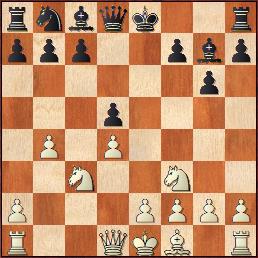 |
 |
 |
(3) Vladimir Kovacevic - Yasser Seirawan [B07]
Hoogovens Wijk aan Zee NED (9), 26.01.1980
1.d4 g6 2.e4 d6 3.Nc3 Bg7 In his early years Yasser preferred the PIrc Defense with Black. 4.Be2 Nf6 5.g4 c6 6.g5 Nfd7 7.h4 b5 8.h5 Rg8 9.hxg6 hxg6 10.Nf3 White could well have considered holding up the Black pawn advance with 10. a3. 10...b4 11.Nb1 a5 We have a fluid, complex position with chances for both sides. There is a lot of choice for both players with where to place their pawns. 12.a4 [12.a3 may be a better choice.] 12...c5 13.d5? giving Black more control of the central dark squares. 13. c3 is a more solid choice. 13...Nb6 14.c4
 |
 |
(4) De Firmian,Nick E - Seirawan,Yasser [B01]
USA-ch U18 Memphis (2), 1976
I can't resist giving one of the encounters I had with Yasser over the years. If he had a weakeness it would be that he would take risks with his king and would sometimes fall for tactics. This game was played long ago in the US Junior Championship. The event was held in Memphis and Elvis was still alive. 1.e4 d5 2.exd5 Qxd5 3.Nc3 Qa5 4.d4 Nf6 5.Nf3 Bg4 6.Bb5+?! c6 7.Bc4 e6 8.h3 Bh5 9.Bd2 Qc7 10.Qe2 Bd6 11.0-0-0 Nbd7 12.g4 Bg6 13.h4 The opening is about equal. With 13...h5! Black has little worry. In the old days Yasser would love to snatch pawns. 13...Nxg4? 14.Bxe6 Black shouldn't have kept the king in the center with the action starting. 14...Ngf6
 |
15.Bxf7+! This surprising move steals a pawn and starts the attack. 15...Kd8 [Taking the bishop would lose immediately - 15...Kxf7 16.Ng5+ Kg8 17.Qc4+ Nd5 18.Nxd5] 16.Bxg6 hxg6 17.Ng5 Kc8 A brave king walk, but there is no coming back from this position. 18.Qd3 Nf8 19.d5 Be5 20.dxc6 bxc6 21.Qa6+ Kb8 22.Na4 N8d7 23.Nf7 Re8 24.Nxe5 Qxe5 25.Rh3 Nd5 26.Rb3+ N7b6 27.Re1 Qxe1+ 28.Bxe1 Rxe1+ 29.Kd2 Re5 30.Nc5 Kc7 31.c4 Nf6 32.Qb7+ Kd6 33.Rxb6 axb6 34.Qxa8 Kxc5 35.b3 Ne4+ 36.Kc2 Rf5 37.Qa3+ Kd4 38.Qb2+ Kc5 39.Qa3+ Kd4 40.Qb2+ Kc5 41.Qxg7 Kb4 42.Qe7+ Nc5 43.Qe1+ Ka3 44.Qc1+ Black resigned. An early game of Yasser's, but he soon became very strong, winning the US Junior the next year and going on to become World Junior Champion. 1-0
Submit your piece or feedback
We would welcome any feedback, articles or "Letter to the Editor" piece. Submit yours today through this Google Form:
https://forms.gle/eLfUyg2yFZ3vxgcMA
You can browse through our archived newsletters using the "next" and "previous buttons".
Want to save this newsletter for reading at a later time? Click here to learn how.
Want to be notified when the next newsletter is published? Join Our Email List →
